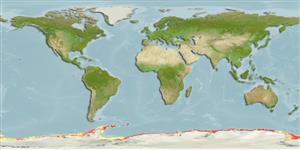Environment: milieu / climate zone / depth range / distribution range
Ecología
marino batidemersal; rango de profundidad 219 - 610 m. Deep-water; 57°S - 78°S
Southern Ocean: circum-Antarctic on continental shelf, insular shelf of the South Sandwich Islands, South Orkney Islands, Elephant Island and South Shetland Island.
Tamaño / Peso / Age
Maturity: Lm ? range ? - ? cm
Max length : 27.1 cm TL macho / no sexado; (Ref. 124149); 28.7 cm TL (female); peso máximo publicado: 84.80 g (Ref. 124149); peso máximo publicado: 84.80 g
Larvae 12-13 mm TL found in November, larval pelagic phase is long (Ref. 41551). Larvae and juveniles present during summer. Food item: amphipods, Euphausia superba. Dependence on krill indicative from association of juveniles with krill concentrations in oceanic waters (Ref. 5192).
Gon, O., 1990. Bathydraconidae. p. 364-380. In O. Gon and P.C. Heemstra (eds.) Fishes of the Southern Ocean. J.L.B. Smith Institute of Ichthyology, Grahamstown, South Africa. 462 p. (Ref. 5192)
IUCN Red List Status (Ref. 130435)
Threat to humans
Harmless
Human uses
Pesquerías: sin interés
Más información
ReferenciasAcuiculturaPerfil de acuiculturaRazasGenéticaElectrophoresesheritabilidadEnfermedadesProcesamientoNutrientsMass conversion
ColaboradoresImágenesStamps, Coins Misc.SonidosCiguateraVelocidadTipo de nataciónSuperficie branquialOtolitosCerebrosVisión
Herramientas
Special reports
Download XML
Fuentes de Internet
Estimates based on models
Preferred temperature (Ref.
123201): -1.8 - 0.7, mean -0.9 °C (based on 472 cells).
Phylogenetic diversity index (Ref.
82804): PD
50 = 0.7500 [Uniqueness, from 0.5 = low to 2.0 = high].
Bayesian length-weight: a=0.00170 (0.00110 - 0.00263), b=3.26 (3.13 - 3.39), in cm total length, based on LWR estimates for this species & (Sub)family-body (Ref.
93245).
Nivel trófico (Ref.
69278): 3.0 ±0.00 se; based on food items.
Resiliencia (Ref.
120179): Medio, población duplicada en un tiempo mínimo de 1.4-4.4 años (Fec = 1,400-1,968).
Fishing Vulnerability (Ref.
59153): Low vulnerability (19 of 100).
